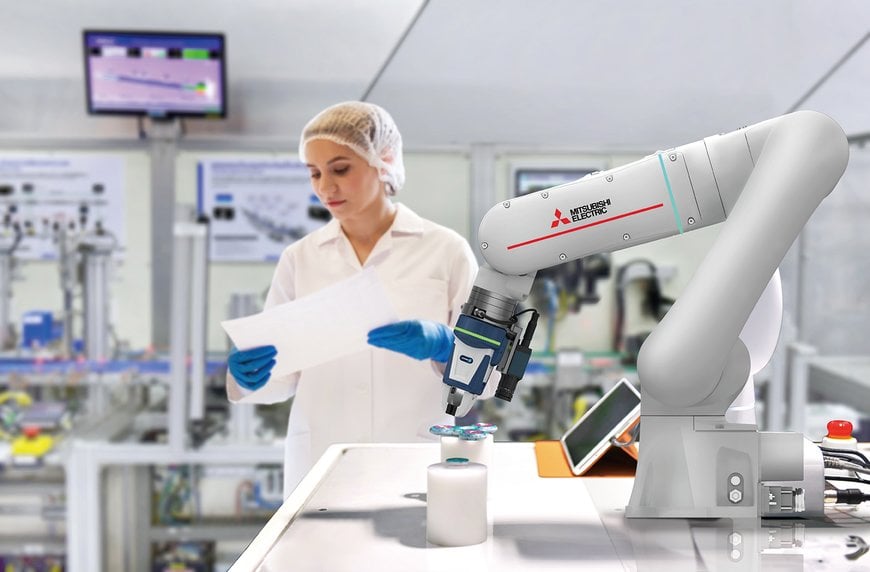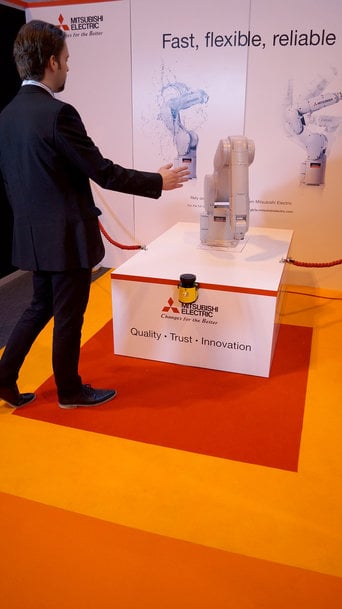www.ptreview.co.uk
11
'21
Written on Modified on
Want a robot but don’t know where to start?
Industrial or collaborative? This is the question everyone is asking.

We all want to get the most out of our production, however the demarcation line between the two options is not as clear as you might think. It all depends on the setting in which the machine operates, how operators need to interact with the robot and its main functions.
Barry Weller, Solutions Marketing Manager – OEM at Mitsubishi Electric, looks at how to identify what type of robot best suits your application and how to integrate it.
The first question that companies interested in automating their processes should ask is: what do we want to achieve? The answer to this will determine the role and type of robot needed. Consequently, conducting a comprehensive risk assessment will shed light on the safety requirements.
For example, if speeding up operations is the main objective behind deploying a robotic solution, conventional industrial robots, such as Mitsubishi Electric’s MELFA RV articulated arm and RH series SCARA robots, are quite likely to be the most suitable option. As the application will dictate, these robots move at high speed which means they are suitable for applications where workspace is to be shared with human operators only by adopting additional safety provisions. The options to integrate them are to construct physical safety perimeter guards or implement systems that allow automated speed control when humans approach the robot working area.
Conversely, if the main goal is assisting employees in their activities, for example by passing or holding parts, the application would be considered collaborative. As a result, any conventional physical separation between humans and robots would obstruct the application. In this case, the ISO/TS 15066:2016 standard supports the development of suitable safety measures, as highlighted by the risk assessment. An example of a robot designed for collaborative applications is Mitsubishi Electric’s MELFA RV series Assista articulated arm robot.
The guidelines indicate different types of collaborative applications which include safety-rated monitored stop, speed and separation monitoring, hand guiding as well as power and force limiting.
This is where the grey area between the two types of robot starts to appear. With the increase in safety options now available, industrial robots can also achieve many of the requirements needed in a collaborative application.

Utilising the speed of an industrial robot within a cooperative environment requires additional safety provisions, such as systems that allow automated speed control when operators approach the robot working area.
Industrial or collaborative robot?
Designed to work alongside humans collaborative robots or ‘cobots’, can provide a safe solution. However, there are some obvious caveats.
The term collaborative, as specified by ISO/TS 15066:2016, actually refers to systems or applications where automatically operated robots share the same workspace with humans. This means that robots for collaborative applications, just like any other type of robot, still require a risk assessment.
There are different industrial operations whose risk assessment would support the use of cobots, for example, if the robot is required to work alongside the human as part of the assembly process to pass objects to operators. Here the risk of a collision between the two is high and so this application would fall into the category of power and force limiting. Features such as safe torque range to detect the impact and prevent injury are needed.
There are situations where the use of robots would require additional safety measures. For example, if potentially harmful chemicals, sharp edges or extremely hot items need to be handled, the robot would need to be enclosed by physical safety perimeter guards to protect human operators. Because of this, the use of a conventional robot is likely to be the right choice for these applications.
In other situations humans may need to infrequently enter a robot’s workspace to briefly interact with the application or there could be a limited area of interaction. These systems will run as fast as possible under normal operation and only slow down when there is a risk of collision. Again this would suggest that a conventional industrial robot would be right for this application due to its ability to operate at high speeds in normal safe operating conditions.
As suggested, the most effective way to make such applications fast, safe and reliable would be to utilise standard industrial robots operating in a cooperative way, coupled with additional safety features such as physical guards or safety light curtains and scanners.
More precisely, businesses can implement high-speed, high-payload industrial robots, such as the MELFA RV articulated arm robot, equipped with a MELFA SafePlus safety system from Mitsubishi Electric. This means humans and robots can work safely and in harmony.
Making the right choice
As technology evolves, the demarcation line between industrial and collaborative robotic applications also changes. The most important consideration when implementing a robotic system is to ensure the system meets the needs of the specific application and delivers against the user requirement specification. The system must achieve both the throughput required and also operate in a safe environment for operators in line with the risk assessment for the application.
The inclusion of collaborative robots has widened the choice and the type of applications that robotics can now be used for. It is not a question of which is best, industrial or collaborative robotics but which is best for the application. With its wealth of experience and proven track record, the robotics team at Mitsubishi Electric helps businesses find the right solution.
www.mitsubishielectric.com

